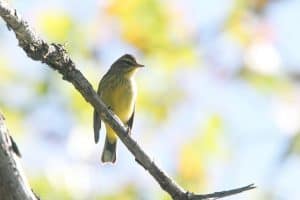The feeling of fall is definitely in the air. Its a lovely time of year, with colorful red maples changing into brilliant red and orange costumes, mushrooms popping up, and purple and white asters blooming in the meadows and woods. We may notice migrating birds passing by or arriving at our feeders for only a day. Many of “our” spring and summer birds such as phoebes, warblers, thrushes, catbirds, and thrushes are leaving us for more abundant food to our south.
Some of these fall migrants fly up to 2000 miles to central and south America, arriving at the exact patch of ground or forest where they spent last winter. Even first year birds arrive to a place they have never before been, and will find their way back to where they were hatched next spring. How can they possibly manage such a feat?
A fascinating new book by Ed Yong, An Immense World: How Animal Senses Reveal The Hidden Realms Around Us , gives us some clues. He presents new research on birds’ and other animals’ magnetic sense. Yong tells us, “Many animals, including salmon, sea turtles, and Manx shearwaters (a type of seabird), can…imprint on the magnetic signature of their birthplaces, etching it deep within their memory so they can find the same sites as adults.”(Yong, pg. 309). It is not known exactly where different animals’ magnetoreceptors are located. In 2000 Klaus Schulten discovered that the songbird’s compass may reside in its eyes in newly discovered molecules called cryptochromes, that detect blue and green light. Henrik Mouritsen found that “Songbirds might be able to see Earth’s magnetic field, perhaps as a subtle visual cue that overlays their normal field of view” (Yong, pg. 314). This could explain how many small songbirds such as warblers can migrate at night, even when the sky is cloudy. They may actually see a map of colored lines leading to home, much as we navigate our cars in unfamiliar areas by following GPS maps. When it comes to navigation, these animals are way ahead of us!
Many thanks to all flora and fauna reporters for the month of September. Please send reports by October 31 for inclusion in next month’s column.
September Reports:
Marian/Bill Harman, Old Colony Drive. September 2, 70’s, sunny. Two female hummingbirds at feeder. A walk to the beaver dam: great blue heron standing in the lily pads at the edge of Keyes Pond. Heard: chickadee, white-breasted nuthatch, titmice, goldfinches, downy woodpecker, red-tailed hawk, catbirds, jays. A little four-inch plant is the only plant coming up all over our brown drought-stricken, back lawn. Its called Common Copperleaf, and is a native of course. It has a little white flower in summer and birds like the seeds. Given climate change, why don’t we have a lawn of this plant rather than grass? September 3, beautiful day. flicker, goldfinch, two female hummingbird at feeder. Several hundred grackles a flying overhead and heading south. September 11, 80 degrees and humid. Juvenile red-bellied woodpecker at feeder, a shy juvenile or female hummingbird, red-breasted nuthatch heard, red-shouldered hawk heard. September 14, a hummingbird, cardinal pair, hairy woodpecker. September 18, a juvenile or female hummingbird helicoptered in tentatively for a few sips. It had zipped right by the feeder, seemed to be giving the feeder a careful look, and then came back. This was probably a migrant on route, and turned out to be the last hummingbird of the season here. September 21, thirty grackles at the feeder for a short time. September 24, 60’s, sunny and lovely. I walked in the meadow: saw and heard jays, cardinal, juvenile red-bellied woodpecker, chickadees, lots of purple and white asters and goldenrod. September 25, 60’s, partly cloudy. At the feeder: lovely crisp male and female hairy woodpeckers (looked like new plumage), goldfinch pair, titmouse, a chickadee, perched on a chair back, looking in at us through the glass slider on the deck, white-breasted nuthatch. A cool fall walk on the beaver dam trail: swamp (red) maple trees are beginning to turn orange, mushroom popping up here and there, a lovely quiet background sound of crickets. A catbird still here in the swamp by the pond–a surprise! Heard cardinals, chickadees, titmice, Carolina wren, downy woodpecker, hairy woodpecker, red-bellied woodpecker, jays. Pine warbler singing beautifully in the blow-down area–a great treat. Small plant found, light blue, 5-pointed petals, yellow center–looks like nightshade.
Carol Nelson, at Forge Village and Main St. A cerulean warbler–rare! Carol sent a great picture and description of the bird.
Marilyn Day, Graniteville Rd. September 11, a pair of flickers in the bird bath.
Meyer and Cindy Franklin, Heywood Rd. September 13, trail cam video showed possum, raccoon, small weasel (later determined to be a mink), two 8-point bucks, one doe, one fawn, another doe with fawn twins, pair of coywolves.
Rosemarie Koester, Providence Rd. September Report: blue jays, a few doves, one pair of cardinals, house finches, goldfinches starting to change color, chickadee, tufted titmouse. Many hummingbirds first week of September, less the next two weeks, none by the end of September. A flicker eating from the ground, a few grackles (I thought they were gone, but they returned this week), downy and red-bellied woodpeckers, one pecking at the house a few times. I saw an eagle overhead a few days ago, as I was driving on Rt.110, hawk circling overhead at home. A few turkeys, squirrels, chipmunks, rabbits (eating my hosta plants), hornet nest under front room window. No sign of caterpillars on my ten milkweed plants, but something is eating the leaves. The white hydrangea had numerous bees and other insects all summer.
Marian Harman is a member of the Westford Conservation Trust, Inc., a non-profit conservation organization, whose purpose is the preservation of Westford’s trails and open spaces. The Trust welcomes new members and volunteers. Check out our website at westfordconservationtrust.org, and visit us on Facebook.

